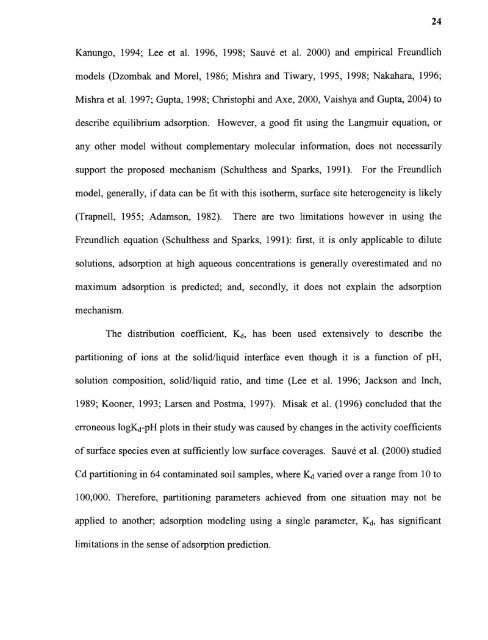Heavy metal adsorption on iron oxide and iron oxide-coated silica ...
Heavy metal adsorption on iron oxide and iron oxide-coated silica ...
Heavy metal adsorption on iron oxide and iron oxide-coated silica ...
You also want an ePaper? Increase the reach of your titles
YUMPU automatically turns print PDFs into web optimized ePapers that Google loves.
24Kanungo, 1994; Lee et al. 1996, 1998; Sauvé et al. 2000) <strong>and</strong> empirical Freundlichmodels (Dzombak <strong>and</strong> Morel, 1986; Mishra <strong>and</strong> Tiwary, 1995, 1998; Nakahara, 1996;Mishra et al. 1997; Gupta, 1998; Christophi <strong>and</strong> Axe, 2000, Vaishya <strong>and</strong> Gupta, 2004) todescribe equilibrium <str<strong>on</strong>g>adsorpti<strong>on</strong></str<strong>on</strong>g>. However, a good fit using the Langmuir equati<strong>on</strong>, orany other model without complementary molecular informati<strong>on</strong>, does not necessarilysupport the proposed mechanism (Schulthess <strong>and</strong> Sparks, 1991). For the Freundlichmodel, generally, if data can be fit with this isotherm, surface site heterogeneity is likely(Trapnell, 1955; Adams<strong>on</strong>, 1982). There are two limitati<strong>on</strong>s however in using theFreundlich equati<strong>on</strong> (Schulthess <strong>and</strong> Sparks, 1991): first, it is <strong>on</strong>ly applicable to dilutesoluti<strong>on</strong>s, <str<strong>on</strong>g>adsorpti<strong>on</strong></str<strong>on</strong>g> at high aqueous c<strong>on</strong>centrati<strong>on</strong>s is generally overestimated <strong>and</strong> nomaximum <str<strong>on</strong>g>adsorpti<strong>on</strong></str<strong>on</strong>g> is predicted; <strong>and</strong>, sec<strong>on</strong>dly, it does not explain the <str<strong>on</strong>g>adsorpti<strong>on</strong></str<strong>on</strong>g>mechanism.The distributi<strong>on</strong> coefficient, Kd, has been used extensively to describe thepartiti<strong>on</strong>ing of i<strong>on</strong>s at the solid/liquid interface even though it is a functi<strong>on</strong> of pH,soluti<strong>on</strong> compositi<strong>on</strong>, solid/liquid ratio, <strong>and</strong> time (Lee et al. 1996; Jacks<strong>on</strong> <strong>and</strong> Inch,1989; Ko<strong>on</strong>er, 1993; Larsen <strong>and</strong> Postma, 1997). Misak et al. (1996) c<strong>on</strong>cluded that theerr<strong>on</strong>eous logKd-pH plots in their study was caused by changes in the activity coefficientsof surface species even at sufficiently low surface coverages. Sauvé et al. (2000) studiedCd partiti<strong>on</strong>ing in 64 c<strong>on</strong>taminated soil samples, where IQ varied over a range from 10 to100,000. Therefore, partiti<strong>on</strong>ing parameters achieved from <strong>on</strong>e situati<strong>on</strong> may not beapplied to another; <str<strong>on</strong>g>adsorpti<strong>on</strong></str<strong>on</strong>g> modeling using a single parameter, Kd, has significantlimitati<strong>on</strong>s in the sense of <str<strong>on</strong>g>adsorpti<strong>on</strong></str<strong>on</strong>g> predicti<strong>on</strong>.
















